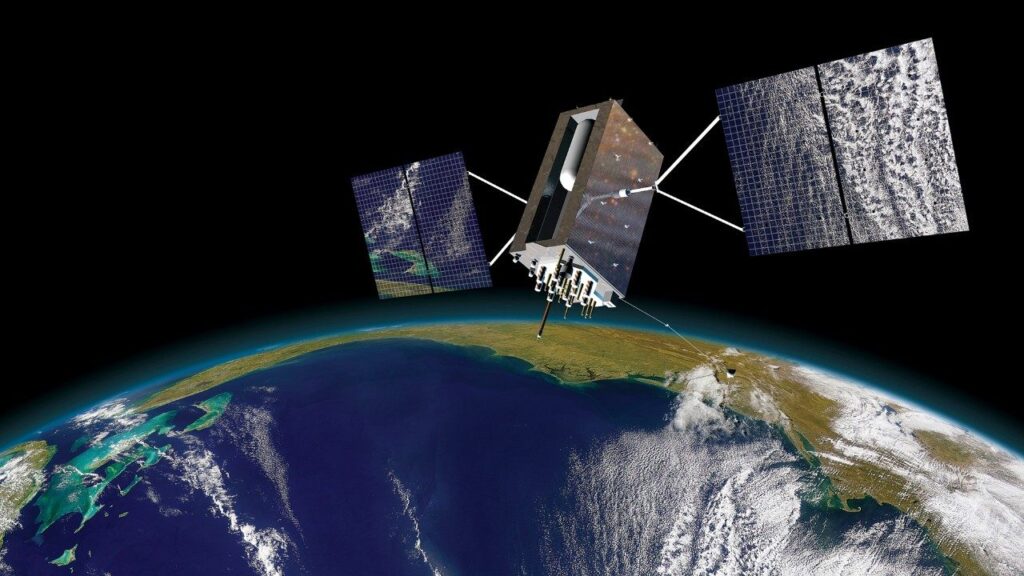
GPS III satellite, (Lockheed Martin image)
WASHINGTON — The Space Force is considering new plans for the future of the Global Positioning System (GPS) constellation — including the possibility of adding more satellites carrying its encrypted military-only signal — in the wake of findings by Congress’s watchdog agency that show likely capability shortfalls.
Government Accountability Office (GAO) reviewed the service’s GPS upgrade efforts in a June 5 report, “GPS Modernization: Space Force Should Reassess Requirements for Satellites and Handheld Devices,” [PDF] and found fault with two major aspects.
The Defense Department “has worked for years to upgrade GPS with a military-specific signal known as M-code,” and “plans to have the needed ground, space, and user equipment ready soon. But it’s unclear whether the current constellation of 24 satellites will meet some users’ accuracy needs. Having 3 more satellites could help, but DOD may not be able to keep all 27 available consistently over the next decade,” the GAO report explained.
“Separately, DOD is working on new user equipment, including a new handheld GPS receiver. But the receiver will likely fall short of its performance goals, and military customers aren’t committed to buying it yet,” the report added. (The M-code user segment has been notoriously behind schedule and over budget.)
Frank Calvelli, head of the Air Force Space Acquisition and Integration Office, in an appendix to the report, fully concurred and accepted the watchdog office’s two recommendations that:
- The service consider officially adding three more M-Code capable satellites to its current operational requirement of 24 to improve accuracy to levels needed to reach the accuracy requirements of M-Code user equipment — requirements that also were approved by the Space Force.
- Space Force either re-do requirements or drop altogether plans to develop a new, smaller M-Code chip card and a specialized GPS receiver for handheld radios, citing a lack of a “sound business case” because the other services (especially the Army) are pursuing their own solutions.
GAO reports that “as recently as 2021,” the Space Force re-affirmed the approved requirement of 24 M-code satellites to reach full operational capability of the jam-resistant signal for military-only use. All 24 of those are now on orbit, including five of the latest-model GPS III birds, as well GPS IIR-M and GPS IIF satellites. (There are 38 GPS sats in total on orbit; 31 of them active, and the rest spares.)
However, GAO found, “studies from as early as 2019 indicated the need for a larger constellation to provide the coverage needed for M-code user equipment” — including from the Pentagon’s top tester’s office, the independent Institute of Defense Analysis, and the Space Force’s own internal analysis.
The Space Force has a two-pronged effort underway to develop new computer chip-carrying cards to retrofit existing platforms, such as aircraft and ships, so they can ingest M-code signals, as well as to develop a new handheld receiver. The studies cited by GAO revealed that based on the requirements for those user equipment programs — requirements set by the Space Force itself — the actual number of M-code broadcasting satellites needed is 27.
“These systems, thus, have conflicting approved requirements: a 24-satellite constellation is the approved requirement of the space segment, but 27 satellites are, in fact, necessary to meet user equipment approved requirements,” GAO stressed. “According to Space Force officials, Space Force does not have an approved requirement for a 27 M-code satellite constellation,” although there are informal plans “to continue adding to the constellation.”
The congressional watchdog is not convinced that approach will be adequate.
“Building and maintaining this larger constellation presents a challenge. GAO’s analysis indicates it is not likely that 27 satellites will be available on a consistent basis over the next decade. Unless the Air Force assesses its operational need for satellites to establish a firm requirement for a 27-satellite constellation, other DOD efforts could take priority, leaving the warfighter with GPS user equipment performing below the required capability levels,” the report said.
Prime contractor Lockheed Martin in 2018 won a contract to build 10 GPS III satellites, and in 2018 nabbed a new contract worth $7.2 billion to develop up to 22 more of the upgraded GPS IIIF (for follow-on) variants. These satellites will replace the older models carrying the M-code on a rolling basis.
However, in briefing reporters in March on the Air and Space Force fiscal 2024 budget requests, Air Force Secretary Frank Kendall said an overarching strategy for GPS remains up in the air — and the Space Force has paused new orders as it currently has a backlog of satellites awaiting launch.
Six GPS III satellites have been launched, and the other four already have been delivered by Lockheed Martin. As for GPS IIIF, the Space Force so far has only placed firms orders for 10.
The Space Force asked for a total of around $1.2 billion in FY24 for what it calls the GPS “enterprise;” that is, the space, ground and command and control segments all together.
L3Harris selloffs hampered by low bids, CEO says
“To the extent we can get a good price for what we’ve identified as non-core [businesses], we’ll do it. But too many of the offers are coming in low and people think we’re desperate to sell, and I can assure you we’re not,” said L3Harris CEO Chris Kubasik.



























